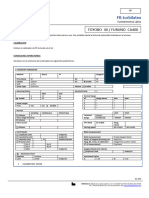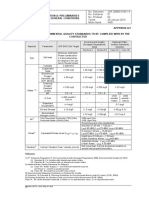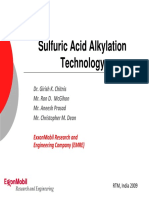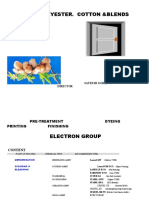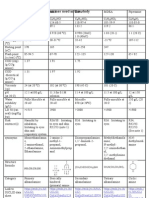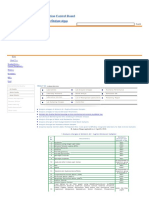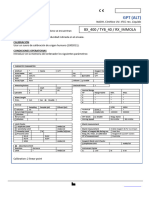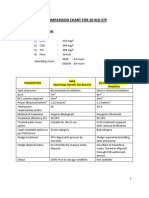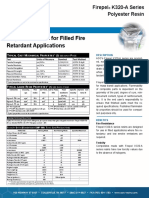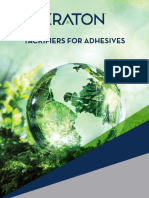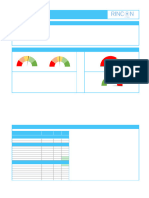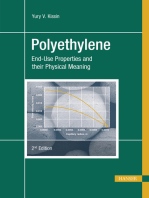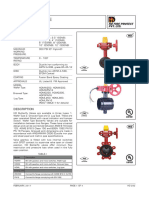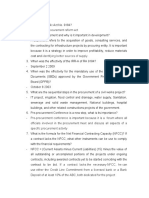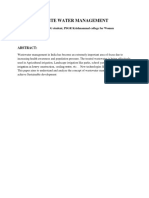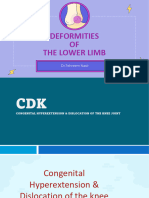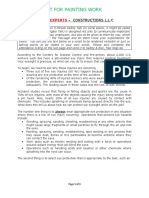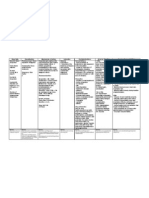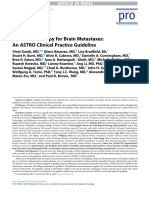14072018XFWAYPL3RiskGSFC (1)
14072018XFWAYPL3RiskGSFC (1)
Uploaded by
Satish IndiaCopyright:
Available Formats
14072018XFWAYPL3RiskGSFC (1)
14072018XFWAYPL3RiskGSFC (1)
Uploaded by
Satish IndiaCopyright
Available Formats
Share this document
Did you find this document useful?
Is this content inappropriate?
Copyright:
Available Formats
14072018XFWAYPL3RiskGSFC (1)
14072018XFWAYPL3RiskGSFC (1)
Uploaded by
Satish IndiaCopyright:
Available Formats
RISK AND HAZARD STUDY
GENERAL
This chapter deals with additional studies such as public consultation, risk assessment and other
related studies. Fertilizer Industry is associated with potential hazards that effect to the man and
natural environment. It would normally require the assistance of emergency services to handle it
effectively. The operation shall be taken out under the well management and control by the qualified
safety manager. Disaster management plan has to be formulated with an aim of taking precautionary
steps to avert disasters and also to take such action after the disaster which limits the damage to the
minimum.
1.1 RISK AND HAZARD STUDY
The methodology includes,
Hazard identification,
Selection of potential loss scenarios,
Simulation of release source model on DNV‟s PHAST, Version 6.7
Plotting the damage contour on site map
These steps undertaken to carry out risk assessment for this project are described below in Chapter.
1.1.1 Details of Storage Facilities at Site
GSFC have various products which may involve risk at different level. The storage facility and physic-
chemical properties of various goods are given in Table 1.1.
Table: 1.1 Storage Facility of Products
Capacity
Number
of Above Operatin
of Type of Operating
Name of Physical Storage ground/ g
# storage Supply/ Temprature
Chemical state Tank Undergroun Pressure
tanks/ Storage (°C)
(KL*) d (bar)
cylinders
each
Vapour
Ammonia is
Above
1. Ammonia Vapour - - directly Atmospheric 2.45
Ground
available
from plant
11,900
Sulphiric Above Atmosph
2. Liquid - MT. MS Atmospheric
Acid Ground eric
(6470 KL)
QRA for AS-I Plant (1,46,000 TPA) by Gujarat State Fertilizers & Chemicals Ltd. Vadodara Gujarat
Table 1.2 Physico-chemical properties of Goods
Mol. Boilin Meltin
Hazardous CAS Wt g g Flash LEL UEL IDLH Hazar
# State Formula Color Odour LD50 LC50
Chemical No. (g/mol Point Point Point % % (ppm) d
e) (°C) (°C)
(LD50): 2000
Ammoni Not Toxic
7664- Colorles 350 ppm / 4
1 Ammonia Liquid NH3 a-like 17.03 -33.4 -77.77 Applic 15 28 300 &
41-7 s mg/kg Hrs
(Strong) able Irritant
[Rat]. [Rat]
(LC50):
Not Not (LD50):
Not 15 510
Sulphuric 7664- Colorles Odorles appli appli 2140 Corro
2 Liquid H2SO4 98.08 338 10.5 applic mg/m mg/m3/
Acid 93-9 s s cabl cabl mg/kg sive
able 3 2Hrs[Ra
e e [Rat.]
t]
Toxic
(LD50):
and
Brownis 640
Ammonium 7783- Odorles < Slightl
3 Solid (NH4)2SO4 h gray 132.14 NA 280 NA NA 300 mg/kg NA
Sulphate 20-2 s 93.3 y
to white [Mouse
flamm
].
able
(LD50):
(NH2)2CO or 57-13- Odorles 8471
4 Urea Solid White 60.06 NA 132.7 NA NA NA NA NA Irritant
CH4N2O 6 s mg/kg
[Rat].
(LD50):
108- < 3161
5 Melamine Solid C3-H6-N6 White NA 126.12 NA <250 NA NA NA NA Irritant
78-1 93.3 mg/kg
[Rat]
Not Not (LD50):
Clear Not Not Corro
Phosphoric Not Odorles appli appli 1530
6 Liquid Mixture Colorles applica 158 21 applic NA NA sive &
Acid applicable s cabl cabl mg/kg
s ble able Irritant
e e [Rat]
LD50
Phosphogyps Odourle oral rat
7 Solid CaSO4. 2H2O Mixture Gray NA NA NA NA NA NA NA NA -
um ss > 5000
mg/kg
Rat - Rat -
105- Colourle 136 -
8 Caprolactum Solid C6H11NO NA 113.16 68 - 71 152 1.6 11.9 1,210 300 Irritant
60-2 ss 138
mg/kg mg/m3
Acrid.
Colorles Not
Disagre Not Not
Not s To Appli Corro
9 Nitric acid Liquid Mixture eable Applica 121 -41.6 Applic NA 25 NA NA
Applicable Light cabl sive
and ble able
Yellow e
choking.
Eco Chem Sales & Services, Surat 2
QRA for AS-I Plant (1,46,000 TPA) by Gujarat State Fertilizers & Chemicals Ltd. Vadodara Gujarat
Mol. Boilin Meltin
Hazardous CAS Wt g g Flash LEL UEL IDLH Hazar
# State Formula Color Odour LD50 LC50
Chemical No. (g/mol Point Point Point % % (ppm) d
e) (°C) (°C)
(Strong)
Toxicity
to fish
LC50 -
Pimeph
Rat - ales
96-29- Colourle Flam
10 MEK Oxime Liquid C4H9NO Mild 87.12 152.22 -29.5 62 1.5 5.3 NA 930 promela
7 ss mable
mg/kg s
(fathead
minnow
) - 843
mg/l
white to
Pellet 25038- 113.08
11 Nylon – 6 NHC5H10CO pale NA NA 223 NA NA NA NA NA NA NA
s 54-4 31
yellow
Rat
Not Not
Not Toxicity
Urea Crysta (NH2)2CO⋅H3 4861 – Odourle 116 - appli appli Corro
12 White 158.0 NA applic NA (LD50) NA
Phosphate ls PO4 19 – 2 ss 117 cabl cabl sive
able : 5840
e e
mg/Kg
Alcohol
(LD50): (LC50):
like.
67-56- Colorles 5628 64000 4 Flam
13 Methanol Liquid CH3OH Pungent 32.04 64.5 -97.6 12 6 36.5 6000
1 s mg/kg hours mable
when
[Rat] [Rat]
crude
NA- Not Available
Table 1.3 Scenarios for Simulation
Full name of Size of Pipeline
Hazard Maximum Operating Consequences
# the Raw Types of Failure Possible
involved No. Dia Length Pressure Studied
Material
20% rupture of incoming pipeline from
6” Toxic Dose
Toxic & 1.5 km Atmospheric (1.0 Ammonia IV plant to AS-I Plant
1. Ammonia 1 (152.4 2
Irritant (1500 m) kg/cm ) FB rupture of incoming pipeline from
mm) Toxic Dose
Ammonia IV plant to AS-I Plant
Eco Chem Sales & Services, Surat 3
QRA for AS-I Plant (1,46,000 TPA) by Gujarat State Fertilizers & Chemicals Ltd. Vadodara Gujarat
1.2 QUALITATIVE RISK ASSESSMENT
Many times risk involved in various processes / process equipment cannot be addressed
completely by consequence analysis. As a conservative approach, these risks have been
considered separately under this topic. The approach is to identify hazards associated in
operation of equipment as well as in processes, assessing its impacts, ranking the risk posed by
it and finally to propose remedial actions/mitigation measures such that the risk is minimized to
tolerable level.
Qualitative Risk Assessment has been carried out for the following areas:
Storage and handling of solid chemicals like ammonium Sulphate, urea, urea phosphate
etc.
Storage and handling of corrosive chemicals like Sulphuric acid, phosphoric acid, etc.
Storage and handling of toxic chemicals like ammonium Sulphate and Ammonia.
Risk involved in various processes / process equipment cannot be addressed completely by
consequence analysis. As a conservative approach, these risks have been considered
separately under this topic. The approach is to identify hazards associated in operation of
equipment as well as in processes, assessing its impacts, ranking the risk posed by it and finally
to propose remedial actions/mitigation measures such that the risk is minimized to tolerable
level. The risk matrix presented in Table 1.4, is referred in evaluating the assessment. Risk
acceptability criteria given in Table 1.5.
Table: 1.4 Risk Matrix for Qualitative Risk Assessment
SEVERITY
Major/ Moderate Minor/
Catastrophic Critical (Less Marginal
Likelihood/ Insignificant/Negligible
(Death/ (Serious Serious (Minor
Probability (No injury /illness)
System Loss) injury/ Injury/ Injury/
Illness) Illness) Illness)
5 4 3 2 1
Almost
E H H H M M
Certain
Likely D H H M M L
Possible C H M M M L
Unlikely B M M M L L
Impossible A M M L L L
Table 1.5: Risk Acceptability Criteria
Risk Risk Acceptability
Remarks
Range Criteria
H Unacceptable/ High Management‟s Decision/Action Plan Required. Potential off-site Impact.
Generally Minor Impact. Acceptable with Management‟s Review.
M Medium
Specific monitoring or SOP to be followed.
L Low Acceptable without Review. Manage through Routine Procedure.
Eco Chem Sales & Services, Surat
4
QRA for AS-I Plant (1,46,000 TPA) by Gujarat State Fertilizers & Chemicals Ltd. Vadodara Gujarat
Table 1.6 Associated Hazards and its Mitigation Measures during Storage and handling of Solid Chemicals
Initial Risk Residual Risk
S. Associated
Likelihood
Likelihood
Process Or Health & Safety
Severity
Severity
Mitigation Measures
Activity Impact (Risk)
Risk
Risk
No. Hazards
1. Handling Chemical Exposure Skin/Eye/lung 4 C M Operators/Workers is/will be trained 2 B L
Chemical bags irritation. for Safe Work Practices.
Chemical handling bags is/will be
labeled properly.
Chemicals will be stored in an
isolated storage rooms having
provision for natural & forced
ventilation.
Certified Dust respirator will be
provided.
Use of suitable protective clothing
like apron, Helmet splash goggles,
face shields and hand gloves.
Ground to all equipment containing
material will be done.
Urea and Melamine will be stored
below 23°C in tightly closed
container.
Will be kept away from
incompatibles such as oxidizing
agents, metals, acids and alkalis.
2. Cleaning of Fumes Inhalation. Severe irritation 3 C M In case of large spillage of urea and 1 B L
Chemical Dust Exposure. to eyes, skin. Melamine finish cleaning by
Spillage. Inhalation. spreading water on the
Splashing
contaminated surface and allow to
evacuate through the sanitary
system.
In case of spillage of urea
phosphate collect the dry product
mechanically without creating any
dust for recovery or disposal.
Eco Chem Sales & Services, Surat 5
QRA for AS-I Plant (1,46,000 TPA) by Gujarat State Fertilizers & Chemicals Ltd. Vadodara Gujarat
Initial Risk Residual Risk
S. Associated
Likelihood
Likelihood
Process Or Health & Safety
Severity
Severity
Mitigation Measures
Activity Impact (Risk)
Risk
Risk
No. Hazards
In case of spillage of
phosphogypsum do not allow into
drains or water courses.
Use of NIOSH-approved air-
purifying or supplied-air respirator
where airborne concentrations of
dust are expected to exceed
exposure limits.
Use of protective eyeglasses or
chemical safety goggles as
described by OSHA´s eye and face
protection regulations in 29 CFR
1910.133 or European standard
EN166.
Use of Suitable protective clothing,
gloves, boots and approved
respiratory PPE‟s will be ensured.
Eco Chem Sales & Services, Surat 6
QRA for AS-I Plant (1,46,000 TPA) by Gujarat State Fertilizers & Chemicals Ltd. Vadodara Gujarat
Table 7.7 Storage and Handling of Corrosive chemicals
Initial Risk Residual Risk
S. Process or Associated Health & Safety
Severit
Severit
Likelih
Likelih
Mitigation Measures
Risk
Risk
ood
ood
No. Activity Hazards Impact (Risk)
y
1. Loading & Exposure to acid Skin/Eye 4 C M Loading & Unloading activity 2 B L
Unloading. fumes (due to irritation. is/will be carried out in well-
leakage in pipe/ Toxic Vapor ventilated area under proper
container/ valves inhalation etc. supervision.
etc.). Periodic Inspection of
Spillage. flanges/ferrule joints is/will
be carried out.
Neutralization media is/will
be kept available in areas
where acids are
stored/handled/used.
Training for lifting and
chemical transporting
technique from one location
to another location is/will be
provided periodically.
Use of Nitrile rubber gloves,
over 0.11 mm thickness, >
480 min breakthrough time
for handling Urea
phosphate.
PPEs like chemical safety
goggles or full face shield,
Rubber or neoprene gloves
and additional protection
including impervious boots,
apron will be used.
Eco Chem Sales & Services, Surat 7
QRA for AS-I Plant (1,46,000 TPA) by Gujarat State Fertilizers & Chemicals Ltd. Vadodara Gujarat
NIOSH an approved
respirator is/will be used.
Use of acid-resistant PVC or
neoprene jacket.
2. Working in Exposure to acid Severe 3 C M Acid proof floorings has 2 B L
Storage Area. fumes. irritation to been constructed.
eyes, skin. Storage area is/will be well
Body burns. ventilated.
NIOSH approved
Respirators shall be used.
Dyke wall is/will be
provided.
In case of spillage of
Phosphoric acid, H2SO4 and
Nitric acid absorb with DRY
earth, sand or other non-
combustible material,
Neutralize the residue with a
dilute solution of sodium
carbonate.
PPEs like chemical safety
goggles or full face shield,
Rubber or neoprene gloves
and additional protection
including impervious boots,
apron will be used.
Eye wash stations & Safety
Shower is/will be installed in
near vicinity.
Only trained personnel
is/will be allowed to work in
this area.
3. Leakage from Exposure to acid Severe 3 B M Level indicator is/will be 2 B L
fumes. irritation to provided.
Eco Chem Sales & Services, Surat 8
QRA for AS-I Plant (1,46,000 TPA) by Gujarat State Fertilizers & Chemicals Ltd. Vadodara Gujarat
joints etc. eyes, skin. Dyke wall shall be provided.
Other measures remaining
are same as above.
Table 7.8 Storage and Handling of Toxic chemical like Ammonium Sulphate and Ammonia.
Initial Risk Residual Risk
Likelihoo
Likelihoo
S. Process Or Associated Health & Safety
Severity
Severity
Mitigation Measures
Activity Hazards Impact (Risk)
No.
Risk
Risk
d
d
1. Chemical Exposure to Eye and skin 4 C M SOPs is/will be prepared and 2 B L
handling / vapours (due irritation, eye same will be followed.
Loading & to leakage burns, Containers is/will be stored in
Unloading from joints, corrosive well-ventilated area and away
corroded burns to skin from all possible sources of
lines failure and ignition.
etc.). respiratory Eye wash station and Safety
disorder. Shower is/will be installed in
nearby location of storage
facility.
Employee is/will be provided
with protective equipment like
aprons (full suit), vapour
respirator, gloves, boots and
splash goggles.
Handling trainings is/will be
provided to the operators/
workers periodically.
Spill control procedure is/will be
made available at storage
facility.
Provided an automatic leak
detection system.
2. Working in Exposure to Severe burns, 4 C M Use of provided PPE‟s is/will 2 B L
Eco Chem Sales & Services, Surat 9
QRA for AS-I Plant (1,46,000 TPA) by Gujarat State Fertilizers & Chemicals Ltd. Vadodara Gujarat
Initial Risk Residual Risk
Likelihoo
Likelihoo
S. Process Or Associated Health & Safety
Severity
Severity
Mitigation Measures
Activity Hazards Impact (Risk)
No.
Risk
Risk
d
d
Storage Area vapours due corneal be ensured by Safety officer/
to spillage. damage, Plant In-charge.
possible Eye wash station or Safety
irreversible Shower is/will be installed in
eye damage storage area and its working
etc. will be ensured by EHS officer.
Exposure may Display of Safety warning
result in postures/signs inside the area,
severe also will be stored in light-
irritation and / resistant containers.
or burns of the Will be kept away from
nose, throat oxidizing materials, heat,
and sparks, and flame.
respiratory Will not use non-ferrous metals
tract. It may such as copper, brass, bronze,
cause tin, zinc or galvanized metals
bronchospasm container for the storage and
, pulmonary pipelines for handling of
edema or ammonia.
respiratory NIOSH approved respiratory
arrest. protection that consists of a
full-face gas mask and
canisters approved for
ammonia or SCBA will be used
and made available.
3. Tank overflow Chemical Severe irrit 5 C H Level indicator will be installed 2 B L
Exposure ation, eye and the same shall be checked
burns or for its proper operation.
permanent Periodic inspection will be
eye damage. carried for all the related
Contact with accessories of level indicator.
Eco Chem Sales & Services, Surat 10
QRA for AS-I Plant (1,46,000 TPA) by Gujarat State Fertilizers & Chemicals Ltd. Vadodara Gujarat
Initial Risk Residual Risk
Likelihoo
Likelihoo
S. Process Or Associated Health & Safety
Severity
Severity
Mitigation Measures
Activity Hazards Impact (Risk)
No.
Risk
Risk
d
d
liquid may Approved respiratory
produce a equipment‟s will be made
caustic burn available.
and frostbite.
Fatality
Eco Chem Sales & Services, Surat 11
QRA for AS-I Plant (1,46,000 TPA) by Gujarat State Fertilizers & Chemicals Ltd. Vadodara Gujarat
1.3 QUANTITATIVE RISK ASSESSMENT
Quantitative Risk Assessment (QRA) is a structured approach to identifying and understanding
the hazards and risks associated with Storage and Handling of flammable/ toxic chemicals. The
assessment starts by taking into account an inventory of hazardous chemicals stored, likelihood
of leakage/ spillage associated with it and selecting the worst case scenario for consequence
estimation. Finally, suggesting the measures to minimize or mitigate risks to meet appropriate
acceptability criteria. The planning for emergency evacuation shall be borne in mind whilst
interpreting the results.
Consequence analysis
In a plant handling hazardous chemicals, the main hazard arises due to storage and handling of
hazardous chemicals as mentioned above. If these chemicals are released into the atmosphere,
it may cause damage due to resulting fires or vapor clouds. Blast overpressures depend upon
the reactivity class of material between two explosive limits.
Damage criteria
In consequence analysis studies, in principal three types of exposure to hazardous effects are
distinguished:
1. Heat radiation, from jet fire, pool fire, a flash fire or a BLEVE
Explosion
Toxic effects, from toxic materials or toxic combustion products.
The chosen damage criteria are given and explained as per the Guidelines for QRA – PHAST
Software, version 6.7 (DNV) & Purple Book for QRA released by Centre for Chemical Process
Safety (CCPS).
Planning
Hazards that can lead to accidents in operations are discussed in this section. Important
hazardous events are classified in Table 1.9.
Table 1.9: Event Classification
Type of Event Explanation
Boiling Liquid Evaporating Vapor Explosion; may happen due to catastrophic
BLEVE failure of refrigerated or pressurized gases or liquids stored above their boiling
points, followed by early ignition of the same, typically leading to a fire ball
Is the same as detonation but with reaction occurring at less than sonic
Deflagration
velocity and initiation of the reaction at lower energy levels
A propagating chemical reaction of a substance in which the reaction front
Detonation advances in the unreacted substance at or greater than sonic velocity in the
unreacted material
Explosion A release of large amount of energy that form a blast wave
Fire Fire
Fireball The burning of a flammable gas cloud on being immediately ignited at the
edge before forming a flammable/explosive mixture.
Flash Fire A flammable gas release gets ignited at the farthest edge resulting in flash-
Eco Chem Sales & Services, Surat
12
QRA for AS-I Plant (1,46,000 TPA) by Gujarat State Fertilizers & Chemicals Ltd. Vadodara Gujarat
Type of Event Explanation
back fire
A jet fire occurs when flammable gas releases from the pipeline (or hole) and
Jet Fire the released gas ignites immediately. Damage distance depends on the
operating pressure and the diameter of the hole or opening flow rate.
Pool fire is a turbulent diffusion fire burning above a horizontal pool of
Pool Fire
vaporizing hydrocarbon fuel where the fuel has zero or low initial momentum
„Loss of containment‟. Release of fluid or gas to the surroundings from unit‟s
Spill Release own equipment / tanks causing (potential) pollution and / or risk of explosion
and / or fire
Structural Breakage or fatigue failures (mostly failures caused by weather but not
Damage necessarily) of structural support and direct structural failures
Vapor Cloud Explosion resulting from vapor clouds formed from flashing liquids or non-
Explosion flashing liquids and gases
Hazard and Damage Assessment
Toxic, flammable and explosive substances released from sources of storage as a result of
failures or catastrophes, can cause losses in the surrounding area in the form of:
Toxic gas dispersion, resulting in toxic levels in ambient air,
Fires, fireballs, and flash back fires, resulting in a heat wave (radiation), or
Explosions (Vapor Cloud Explosions) resulting in blast waves (overpressure).
Consequences of Fire/Heat Wave
The effect of thermal radiation on people is mainly a function of intensity of radiation and
exposure time. The effect is expressed in term of the probability of death and different degree of
burn. The consequence effects studied to assess the impact of the events on the receptors are:
Table 1.10: Damage due to Radiation Intensity
Radiation
Damage to Equipment Damage to People
(kW/m2)
1.2 Solar heat at noon -
1.6 - Minimum level of pain threshold
2.0 PVC insulated cable damage -
Causes pain if duration is longer
4.0 - than 20 sec. But blistering is
unlikely.
Pain threshold reached after 8 sec.
6.4 -
Second degree burns after 20 sec.
Minimum energy to ignite wood with a 1% lethality in one minute. First
12.5
flame; melts plastic tubing. degree burns in 10 sec.
16.0 - Severe burns after 5 Sec.
Minimum energy to ignite wood at
100% lethality in 1 min. Significant
25.0 identifying long exposure without a
injury in 10 sec.
flame.
Eco Chem Sales & Services, Surat
13
QRA for AS-I Plant (1,46,000 TPA) by Gujarat State Fertilizers & Chemicals Ltd. Vadodara Gujarat
Radiation
Damage to Equipment Damage to People
(kW/m2)
100% lethality in 1 min.
37.5 Severe damage to plant 50% lethality in 20 sec.
1% lethality in 10 sec.
Consequences of Overpressure
The effects of the shock wave vary depending on the characteristics of the material, the quantity
involved and the degree of confinement of the vapor cloud. The peak pressures in an explosion
therefore vary between a slight over-pressure and a few hundred kilopascals (kPa). Whereas
dwelling are demolished and windows and doors broken at overpressures as low as 0.03- 0.1
bar. Direct injury to people occurs at greater pressures. The pressure of the shock wave
decreases rapidly with the increase in distance from the source of the explosion.
Table 1.11: Overpressure Damage
Overpressure
Damage
(bar)
0.001 Annoying noise (137 dB if of low frequency 10-15 Hz)
0.002 Loud noise (143 dB, sonic boom glass failure
0.003 Occasional breaking of large glass windows already under strain
0.007 Breakage of small windows under strain
0.010 Typical pressure for glass breakage
0.020 projectile limit; some damage to house ceilings; 10% window glass broken
0.027 Limited minor structural damage
0.034 Large and small windows usually shattered; occasional damage to window
0.034 to 0.068 frames
0.048 Minor damage to house structures
0.068 Partial demolition of houses, made uninhabitable
Corrugated asbestos shattered; corrugated steel or aluminum
0.068 to 0.136 panels, fastenings fail, followed by buckling, wood panels (standard
housing) fastenings fail, panels blown in
0.088 Steel frame of clad building slightly distorted
0.136 Partial collapse of walls and roofs of houses
0.136 to 0.204 Concrete of cinder brick walls, not reinforced, shattered
0.157 Lower limit of serious structural damage
50% destruction of brickwork of houses
0.170
Heavy machines (3,000 lb) in industrial building suffered little damage; steel
0.204
frame building distorted and pulled away from foundations.
Frameless, self -framing steel panel building demolished; rupture of oil
0.204 to 0.272
storage tanks
0.272 Cladding of light industrial buildings ruptured
0.340 Wooden utility poles snapped; tall hydraulic press (40,000 lb) in building
slightly damaged
0.340 to 0.476 Nearly complete destruction of houses
0.476 Loaded train wagons overturned
0.476 to 0.544 Brick panels, 8-12 inches thick, not reinforced; heavy machine tools (7,000
Eco Chem Sales & Services, Surat
14
QRA for AS-I Plant (1,46,000 TPA) by Gujarat State Fertilizers & Chemicals Ltd. Vadodara Gujarat
Overpressure
Damage
(bar)
lb) moved and badly
0.612 Loaded trains boxcars completely demolished
0.680 Probable total destruction of buildings; heavy machines tools (7,000 lb)
moved and badly damaged, very heavy machines tools (12,000 lb) survived.
20.414 Limit of crater lip
Source: CCPS Consequence analysis of chemical release
Consequences of Toxic Release
The effect of exposure to toxic substance depends upon the duration of exposure and the
concentration of the toxic substance.
Short-term exposures to high concentration give Acute Effects while long term exposures to low
concentrations result in Chronic Effects.
Only acute effects are considered under hazard analysis. Since they are likely credible
scenarios. These effects are:
Irritation (respiratory system skin, eyes)
Narcosis (nervous system)
Asphyxiation (oxygen deficiency)
System damage (blood organs)
Following are some of the common terms used to express toxicity of materials.
Threshold Limit Value (TLV): it is the permitted level of exposure for a given period on a
weighted average basis (usually 8 hrs. for 5 days in a week)
Short Time Exposure Limit (STEL): It is the permitted short term exposure limit usually
for a 15 minutes exposure.
Immediately Dangerous to life and health (IDLH): It represents the maximum
concentration of a chemical from which, in the event of respiratory failure, one could
escape within 30 minutes without a respirator and without experiencing any
escape/impairing (eg. Severe irritation) or irreversible health effects.
Lethal Concentration Low (LCLo): It is the lowest concentration of a material in air, other
than LC50, which has been reported to cause a death in human or animals.
Toxic Concentration Low (TCLo): It is the lowest concentration of a material in air, to
which humans or animals have been exposed for any given period of time that has
produced a toxic effects in humans or produced carcinogenic, neoplastigenic or
teratogenic effect in humans or animals.
Emergency Response Planning Guidelines 1 (ERPG1): The maximum airborne
concentration below which it is believed that nearly all individuals could be exposed for
up to 1 hour (without a respirator) without experiencing other than mild transient adverse
health effects or without perceiving a clearly defined objectionable odor.
Emergency Response Planning Guidelines 2 (ERPG2): The maximum airborne
concentration below which it is believed that nearly all individuals could be exposed for
Eco Chem Sales & Services, Surat
15
QRA for AS-I Plant (1,46,000 TPA) by Gujarat State Fertilizers & Chemicals Ltd. Vadodara Gujarat
up to 1 hour without experiencing or developing irreversible or other serious health
effects or symptoms that could impair their abilities to take protective action.
Emergency Response Planning Guidelines 3 (ERPG3): The maximum airborne
concentration below which it is believed nearly all individuals could be exposed for up to
1 hour without experiencing or developing life-threatening health effects.
Meteorology
Atmospheric stability plays an important role in the dispersion of the chemicals. “Stability
means, its ability to suppress existing turbulence or to resist vertical motion”.
Atmospheric stability plays an important role in the dispersion of chemicals. “Stability means, its
ability to suppress existing turbulence or to resist vertical motion”.
Variations in thermal and mechanical turbulence and in wind speed are greatest in the
atmospheric layer in contact with the surface. The air temperature has influenced these
turbulences greatly and air temperature decreases with the height. The rate at which the
temperature of air decreases with height is called Environment Lapse Rate (ELR). It will vary
from time to time and from place to place. The atmosphere is said to be stable, neutral or
unstable according to ELR less than, equal to or greater than Dry Adiabatic Lapse Rate (DALR),
which is a constant value of 0.98 ºC per 100 meters.
Pasquill Stability Classes
Pasquill has defined Six (6) stability classes.
A - Extremely unstable.
B - Moderately unstable
C - Slightly unstable.
D - Neutral
E - Slightly stable.
F - Moderately stable.
Three prime factors that defines Stability
Solar radiation
Night-time sky over
Surface wind
When the atmosphere is unstable and wind speeds are moderate or high or gusty, rapid
dispersion of vapors will occur. Under these conditions, air concentrations will be moderate or
low and the material will be dispersed rapidly. When the atmosphere is stable and wind speed is
low, dispersion of material will be limited and air concentration will be high.
Weather Conditions
Following Weather conditions are selected for consequence analysis
Eco Chem Sales & Services, Surat
16
QRA for AS-I Plant (1,46,000 TPA) by Gujarat State Fertilizers & Chemicals Ltd. Vadodara Gujarat
Table 1.12: Weather Condition Selected
Weather Condition
Time Remarks
Temperature in °C Wind speed m/s Stability Class
Prevalent during the day,
Day Time 35.3 2.0 C
most times of the year
Night Prevalent during the night,
27.8 2.0 E
Time most times of the year
Monsoon Prevalent during the
38.7 4.0 D
Period monsoon months
Consequences Analysis
The consequences of the release of Hazardous substances by failures or catastrophes and the
damage to the surrounding area can be determined by means of models. Models help to
calculate the physical effects resulting from the release of hazardous substances and to
translate the physical effects in terms of injuries and damage to exposed population and
environment. To assess the damage level caused by the various accidental events, it is
essential to firm up the damage criteria with respect to different types of accidents e.g. thermal
radiation, toxicity, explosion overpressure etc.
Consequence analysis involves the application of mathematical, analytical and computer
models for calculation of effects and damages subsequent to a hydrocarbon release accident.
Consequence models are used to predict the physical behavior of the hazardous incidents. The
techniques used to model the consequences of hydrocarbon and other hazardous material
releases cover the following:
Modeling of discharge rates when holes develop in process equipment/pipe
work/pipeline.
Modeling of the size and shape of flammable and toxic gas clouds from releases in the
atmosphere
Modeling of the flame and radiation field of the releases that are ignited and burn as jet
fire, pool fire, flash fire and BLEVE/ Fire ball
Modeling of the explosion fields of releases, which are ignited away from the point of
release
The information normally required for consequence analysis includes meteorological conditions,
failure data of equipment and components, ignition sources, population characteristics within
and outside the plant, acceptable levels of risk etc.
Assumption
For consequence analysis, assumptions regarding Meteorological, Pasquil Stability Classes,
Wind velocity, Ambient Temperature, Relative Humidity, Inventory, Ground Roughness, Model
used etc. are very important. In this report, the following assumptions have been considered.
Meteorological Paste other tables
Atmospheric Conditions: No Inversion
Ambient Temperature: 40°C has been considered as MCA approach.
Eco Chem Sales & Services, Surat
17
QRA for AS-I Plant (1,46,000 TPA) by Gujarat State Fertilizers & Chemicals Ltd. Vadodara Gujarat
Pasquil Stability Classes
Pasquil Stability category C, D & E is considered as conservative approach.
Other assumptions:
Inventory: Release of 100% of the inventory has been considered. For this, failure of the
container has been considered from the bottom.
Storage conditions: Storage conditions have been considered as they are practically
stored at site.
Input data for software (modeling)
For consequence analysis, input data considered are as below:
Volume inventory (Quantity of material)
1. Scenario
Leak
Catastrophic Rupture
2. Leak size
20 % rupture of incoming pipeline
Full-bore rupture of incoming pipeline
3. Storage conditions
Pressure
Temperature
4. Bund details
Bund height
Bund area
5. Weather condition:
Wind speed
Pasquil stability
Atmospheric temperature
Relative humidity
MCAS Development Techniques
As a first step towards risk assessment is to identify the possible release scenarios based on
available information about scenario development for Maximum Credible Accident Scenarios
(MCAS).
Selection of Maximum Credible Loss Scenarios (MCLS’)
Following points are considered while selecting the release scenarios:
Flash point for flammable chemicals
IDLH of Toxic chemicals
Operating/ Storage Temperature and Pressure of the material
Total inventory of the material
Eco Chem Sales & Services, Surat
18
QRA for AS-I Plant (1,46,000 TPA) by Gujarat State Fertilizers & Chemicals Ltd. Vadodara Gujarat
Simulation of Release and Development of Contours
As the MCLS‟ were developed for the selected set of chemicals, the next step is to carry out the
consequence analysis. The consequence analysis results along with their contours are
presented in the following sections. Contours are presented on plant layout.
Figure 1.1 Plant layout
Eco Chem Sales & Services, Surat
19
QRA for AS-I Plant (1,46,000 TPA) by Gujarat State Fertilizers & Chemicals Ltd. Vadodara Gujarat
1.3.1 Ammonia
Radiation level effect distance, overpressure effect distance and toxic dose level effect distance due to the release of Ammonia are
presented below:
Table 1.13: Effect Distance due to Release of Ammonia
Effective Distance in meter to Toxic Level
Met
Material Failure Scenario Consequence
Data ERPG 1 (25 ERPG 2 (150 ERPG 3 (1500 IDLH
ppm) ppm) ppm) (300 ppm)
2.0/E 493.47 171.02 57.33 137.74
20% rupture of incoming pipeline from Ammonia
Toxic Dose 2.0/C 231.57 101.09 57.68 87.21
IV plant to AS-I Plant
4.0/D 237.85 97.17 47.49 82.59
Ammonia
2.0/E 77.88 19.43 7.34 14.34
FB rupture of incoming pipeline from Ammonia IV
Toxic Dose 2.0/C 78.15 32.68 12.19 28.60
plant to AS-I Plant
4.0/D 328.88 125.52 57.52 104.41
# NH- No Hazard
# NR- Not Reached
The contour for effect distance generated for the release of Ammonia is presented below;
Eco Chem Sales & Services, Surat 20
QRA for AS-I Plant (1,46,000 TPA) by Gujarat State Fertilizers & Chemicals Ltd. Vadodara Gujarat
Figure 1.2: Toxic effect distance Contour due to 20% rupture of incoming pipeline from Ammonia IV plant to AS-I Plant
at weather condition 2.0/E
Eco Chem Sales & Services, Surat 21
QRA for AS-I Plant (1,46,000 TPA) by Gujarat State Fertilizers & Chemicals Ltd. Vadodara Gujarat
Figure 1.3: Toxic effect distance Contour due to FB rupture of incoming pipeline from Ammonia IV plant to AS-I Plant at
weather condition 4.0/D
Eco Chem Sales & Services, Surat 22
QRA for AS-I Plant (1,46,000 TPA) by Gujarat State Fertilizers & Chemicals Ltd. Vadodara Gujarat
1.3.2 Results of Consequence Analysis
Summary of effect distance (in m) for worst case scenario of hazardous chemical considered for
consequence analysis are given below:
Effect Distance in Meters at specific Weather condition
Chemical/ Scenario
At IDLH Concentration (in PPM)
Ammonia 137.74 (2.0/E)
Toxic dose effect of Ammonia is within half kilometer distance which is within plant premises
which can be mitigated with adequate measures during emergency within plant premises.
Bore Failure of 3" dia. LPNG line in the battery limit of DAP/AS-I
NG is used in the furnaces of AS-I, PA and DAP plant. NG (P=4kg/cm2 and ambient temp.) leakage
can be in the main header coming from utility plant to acid group of plants through PA/DAP/AS plant
or in the supply line to the furnaces. There can be chance of flash fire if the ignition source is
available to the leaky NG.For consequence analysis, following scenarios have been considered:
i. Full bore failure
The Hazard distances due to pool fire, jet fire and overpressure are given in Table below:
Release Hazard Distance (m)
Mass from release point
Rate(Kg/s)
Scenario Released Event
& Duration
(Kg) 2F 2B 3D 5D
(s)
LFL 3 3 3 2
4.5 NR NR NR NR
Jet fire
12.5 NR NR NR NR
2
RR: 0.04 (KW/m )
Full Bore
12 37.5 NR NR NR NR
Failure
RD: 300
0.03 NH NH NH NH
Over
0.1 NH NH NH NH
Pressure (Bar)
0.3 NH NH NH NH
NR- Not Reached; RR: Release Rate; RD: Release Duration; NH: No Hazard
It may be observed from the above table that there is no hazard as such except the LEL goes up to
a maximum distance of 3m.
Eco Chem Sales & Services, Surat 23
QRA for AS-I Plant (1,46,000 TPA) by Gujarat State Fertilizers & Chemicals Ltd. Vadodara Gujarat
Quantitative Risk assessment and Emergency Action Plan has already been carried for other plants
of GSFC like Ammonia - III Plant, Atmospheric Ammonia Storage Tank & Ammonia Filling Station,
For Ammonia-IV Plant Including Argon Filling Station & VTF, For Methanol Plant Including Tankfarm
(VTF), For Urea - I Plant, For Urea - II Plant, For Melamine - I Plant, For Melamine - II
Plant, For Phosphatic Group Of Plants, For Utility IG, CO -GENERATION – I/III, Steam
Generation & Environment Control Plants, For Nylon - 6 Plant, For Caprolactam - I
Plant, For Caprolactam – II Plant, For Caprolacatm – II (Lc-P&B) Plant, with various failure
cases which is attached as Annexure V.
1.3.3 Specific mitigation measures for safety at storage area for Hazardous
chemicals
Ammonia
Following mitigation measures will be followed in case of Ammonia Leakage:
Evacuate the employees from the area of spill by moving laterally and upwind direction
immediately.
Isolate the affected area.
Stay upwind and use water spray downwind of container to absorb the evolved gas.
Contain spill and runoff from entering drains, sewers, and water systems by utilizing methods
such as diking, containment, and absorption.
Use Ammonia emergency kit to attend the leak.
Only properly trained and equipped persons should respond to an ammonia release.
In Case of a Large Spill NIOSH approved positive-pressure SCBA will be used to avoid
inhalation.
Following Safety Measures is/will be made available to avoid Emergencies related to Ammonia
Leakage:
Ammonia handling area is/will be well ventilated.
Ammonia Emergency kit shall be kept ready at Ammonia shed.
DRY earth, sand or other non-combustible material is/will be provided at shed.
NIOSH approved respiratory protection that consists of a full-face gas mask and canisters
approved for ammonia or SCBA should be made available in ammonia shed.
Oxygen Cylinder shall be available.
Safety shower and eye wash station will be made available in Ammonia shed area.
Full body protection suite and other PPEs shall be kept ready.
Safe Operating procedures and Emergency Response Procedures is/will be followed strictly.
Only trained workers and employers shall be allowed to work for tank loading and unloading.
Will be kept away from mercury, gold, silver, iodine, bromine, silver oxide and silver chloride to
avoid formation of explosive product.
Stainless steel, carbon steel or black iron material shall be used for storage and handling of
ammonia.
It will be stored in cool (26.7°C / 80°F) and well-ventilated areas, with tightly closed containers.
Regular worksite inspection is/will be carried out to ensure occupational safety.
Ammonia tank is/will be provided with dyke wall.
Eco Chem Sales & Services, Surat 24
QRA for AS-I Plant (1,46,000 TPA) by Gujarat State Fertilizers & Chemicals Ltd. Vadodara Gujarat
Should ground all equipment containing material.
Alarm/trip signal devise will be provided for detecting high leakage.
1.3.4 Mitigation Measures against Risk
Based on the risk assessment analysis following precautionary mitigation measures are
recommended for the project.
The installation of all the equipment is/will be as per guidelines of provision of Gujarat
Factories Rule 1963.
For any case of fire emergency, standard type of Firefighting equipment and fire
extinguishers will be provided in the storage area as well as required places in the plant.
Smoking is/will be strictly prohibited inside the plant premises.
Personnel protective equipments meeting OSHA‟s standards will be provide to workers.
First Aid facility and First-aid trained person will be available at the time of chemical handling
operation.
Foam Sprayed on Mock Leakage Fire Water Sprayed Towards a Leakage
Rescue Operation by Fire Personnel A Casualty is being Rescued
Figure 7.4 Photos showing fire rescue operation in GSFC Baroda
Eco Chem Sales & Services, Surat 25
QRA for AS-I Plant (1,46,000 TPA) by Gujarat State Fertilizers & Chemicals Ltd. Vadodara Gujarat
1.4 SAFETY MEASURES FOR TRANSPORTATION, STORAGE AND HANDLING OF
CHEMICALS
A. General safety measures for transportation, storage & handling are listed below.
Layout and location of hazardous chemical storage area shall be based on natural and
Mechanical ventilation.
Spare barrels of sufficient quantity are/will be kept ready for any emergency spillage or
leakage.
Regular inspection of all the drums of hazardous chemicals shall be carried out and
damaged drums shall be separated and disposed to avoid the possibility of catastrophic
rupture.
Display Boards shall be provided on all storage drum which include the name of the
chemicals, material of construction, Calibration of tanks and date of Painting.
The level indicators shall be placed on all storage drums to know the exact liquid level inside
the drum and to avoid the accidental spillage or overflow.
All equipments related to hazardous chemical storage shall be maintained and calibrated
regularly.
Drum trolley is/will be used for the movement of drums of hazardous chemicals to avoid
accident due to manual error.
SOP for handling hazardous chemicals is/will be displayed in local language for safe
operating procedure.
Proper inventory of hazardous chemicals is/will be maintained and buffer stock will be kept
as minimum as possible.
Standard procedure for unloading will be in place and will be implemented for safe unloading
of road tanker.
Static earthing provision is/will be made for tanker unloading.
Water showering system (Automated sprinkling system) is/will be provided to the flammable
liquid storage area, wherever required to avoid the vaporization due to increase in
atmosphere temperature.
On‐site detectors for fire based on heat or smoke detection with alarm system is/will be
provided as required.
Adequate firefighting system is/will be provided as required along with the fire water tank
having capacity 2,00,000.00 KLD.
First aids boxes is/will be provided at prominent places in the plant.
Area is/will be declared as “NO SMOKE ZONE”.
Specific Safety measures for storage and handling of other chemicals and gas cylinders are
given as follows.
i. Storage and Handling of other Chemicals
It will be labeled properly and stored in a cool, well-ventilated and fire resistant area in a
tightly closed container.
Material Safety Data Sheet is/will be displayed in front of respective chemicals.
Proper training and knowledge is/will be provided to workers for physical and chemical
characteristics of the each chemical they are using.
Proper PPEs is/will be provided to the workers.
Proper firefighting equipment is/will be installed at storage yard and maintenance and
calibration for that equipment will be carried out on regular basis.
ii. Storage and Handling of gas cylinders
Store cylinders upright with valve outlet seals and valve protection caps in place.
Store cylinders in accordance with ISO Standard 11625:2007.
Eco Chem Sales & Services, Surat 26
QRA for AS-I Plant (1,46,000 TPA) by Gujarat State Fertilizers & Chemicals Ltd. Vadodara Gujarat
Full and empty cylinders should be segregated and stored separately.
Visually inspect stored cylinders on a routine basis, or at least weekly, for any indication of
leakage or problems
Use of approved regulators for the specific gas.
Move cylinders using a suitable hand truck or cart.
Use a cylinder cage or cradle to lift a cylinder
B. Process Safety Measures
Safety measures are the most important aspect of selection of process technology to ensure safety
in production unit. For the safety in production area some important critical safety measures must be
provided within the process technology/equipment itself.
The details of the general safety measures for process unit are as below;
Process parameters control should be provided vide Standard Operating Procedures.
All reaction vents should be connected to either vapor condensers system or gaseous
scrubber system.
Trained person should be engaged for handling of hazardous materials.
Proper safety precautions should be taken during handling of hazardous materials.
Further all the vessels should be examined periodically by a recognized competent person.
All the vessels and equipments should be well earthed and well protected against Static
Electricity. Also for draining in drums, proper earthing facilities should be provided.
Reaction column pressure and temperature data should be regularly monitored and
assessment of properties of flammable chemicals should be evaluated periodically to avoid
fire/explosion scenarios.
Temperature indicators should be provided near all reactors.
Caution note, safety posters, stickers, periodic training & updation in safety and emergency
preparedness plan must be displayed and conducted.
Total reaction should be carried out in closed jacketed vessel having cooling water supply to
control temperature in case of run-away reaction.
Emergency reactor shutdown system should be implemented.
C. Safety Measures for Drum Storage and Handling
Drums should be stored at designated location or secured in a safety storage cabinet.
Approved methods of equipping a drum and dispensing liquids from it should be followed.
Drums, carboys and related accessories should be inspected on regular basis for
maintenance purpose.
All the vessels and equipment should be earthed properly and protected against static
electricity. Also, proper earthing facilities shall be provided for drums.
Materials should be transferred by pumping through pipeline or by vacuum from drums.
Drums for flammable liquids should have proper closures that can withstand the expected
handling conditions without leaking.
D. Safety Measures for Preventive Maintenance
The safety measures in form of the general Do's & Don'ts for safety in process & other plant area are
as below:
Make sure equipment is empty and fluxed with nitrogen and air.
Eco Chem Sales & Services, Surat 27
QRA for AS-I Plant (1,46,000 TPA) by Gujarat State Fertilizers & Chemicals Ltd. Vadodara Gujarat
Use of proper PPE will be ensured by safety officer.
Check VOC content for flammable vapours and make sure that no flammable vapour
contents.
Keep proper and adequate fire extinguisher near work area.
Check all motors are disconnected and fuse pulled out before maintenance.
Work in any equipment must be conducted in presence of supervisor.
Make sure all process lines are disconnected.
Do not work on equipment without permission from plant head and maintenance head.
Do not allow any employment without pre medical checkup or without checking fitness.
Additional safety measures in form of the checklist covering Do's & Don'ts of preventive
maintenance, strengthening of HSE, manufacturing utility staff for safety related measures is/will be
updated timely and will be made available to all concern department & personnel.
1.5 FIRE FIGHTING SYSTEM / FIRE CONTROL PLAN
By looking to the hazardous nature of process and the chemicals that are handled and processed,
the chances of outbreak of fire cannot be totally ignored. Hence to tackle such a situation, company
has developed proposed, well-resourced and adequate fire protection system. The management has
proposed to keep the following extinguishers at site:
Flame detectors, smoke / temperature actuated heat detectors with alarms, automatic
sprinkler system, shall be installed at conspicuous locations as per the requirements.
Company is/will have Fire Water Tank of adequate capacity to combat the emergency, if
arise, GIDC water reservoir shall also be made available, if required.
Working staff is/will be trained to operate Foam, DCP and CO2 extinguishers.
DG set is/will be available as a separate power backup for fire network.
Company has/will do tie up with GIDC Fire Brigade and nearby companies, for handling
emergency situations.
Electric driven alarms & sirens is/will be placed at the conspicuous locations. Hand Bell shall
be used in case of power failure.
Proponent had provided separate entry and exists with adequate margin all around the
periphery for unobstructed easy movement of the emergency vehicle / fire tenders without
reversing back.
Eco Chem Sales & Services, Surat 28
QRA for AS-I Plant (1,46,000 TPA) by Gujarat State Fertilizers & Chemicals Ltd. Vadodara Gujarat
Figure 1.4: Fire Hydrant Layout Plan
7.5.1 Safety Precautions system for visitor
Visitor card to be provided to each visitor with gate pass & Visitor badge; which will contain the
Rules & Information as below:
ID Badges: ID Badges must be worn and visible at all times. They are to
be returned to the reception desk/security gate when leaving the
premises.
Mobile phone: Mobile phones with a camera function must not be used
on these premises. The use of mobile phones is strictly prohibited in
designated areas
Electronic devices: Electronic devices may not be connected to the
company network without authorization
Smoking is prohibited: Smoking is prohibited on the company
premises. The sale and consumption of tobacco products, alcohol and
other narcotic substances is forbidden
Personal protective equipment (PPE): PPE must be worn in many
areas of site. For your own safety you must wear the appropriate
protective equipment when entering these areas.
Alarm Signal: Obey alarm signals and follow the instructions of the fire
safety team. A triggered piezo siren signal indicates a fire system alarm
and alerts the fire safety team. However, piezo sirens emitting a
continuous tone indicate that you must evacuate the building
Eco Chem Sales & Services, Surat 29
QRA for AS-I Plant (1,46,000 TPA) by Gujarat State Fertilizers & Chemicals Ltd. Vadodara Gujarat
immediately.
Emergency Call: To report an accident or environmental incident,
please call our internal emergency number on XXXX/XXXXXX. Please
contact the emergency services; if there is any immediate danger.
Emergency personnel will provide further instructions. Manual call points
can be used to alert the fire brigade directly in the event of a fire.
Emergency Exit: Please leave the danger zone immediately and warn
people at risk. In the event of fire, try to put out the fire with a fire
extinguisher, if possible. Escape routes are marked in green on the
emergency and evacuation plans displayed inside buildings. In the event
of an evacuation, please proceed to the appropriate assembly point.
Assembly Point: Make your way to one of the designated assembly
points and await further instructions. Report any missing colleagues to
management at the assembly point.
First aid boxes: First aid boxes are provided for treating injuries, and
qualified first aiders are on hand during working hours.
1.6 DISASTER MANAGEMENT PLAN (DMP)
In order to be in a state of readiness to face any accident or disaster caused by the project
operation, a Disaster management plan is required to be prepared. The plan will cover possible
disaster, On and Off-site emergency preparedness plans, establishment of emergency Control
Centre (ECC), Location of emergency services and duties of officers / staff during emergency.
Basic Contents of DMP
Basically, DMP contains following aspects:
a) On – site Emergency Plan
b) Off- site Emergency Plan
Classification of Emergency
LEVEL – 1
The incident or emergency which are confinable, controllable within the plant premises, which under
normal circumstances does not affect area outside the said plant battery limit and controlling does
not involve / require external help. This situation is called emergency stand by and affected unit /
plant have to handle emergency.
It may be due to
- Small pipe/valve rupture or similar leakages that do not affect outside premises.
- Release of toxic chemicals for short duration.
- Small fire in the plant.
LEVEL – 2
Eco Chem Sales & Services, Surat 30
QRA for AS-I Plant (1,46,000 TPA) by Gujarat State Fertilizers & Chemicals Ltd. Vadodara Gujarat
When the incident or emergency is not controlled within 10 to 15 minutes or does not come under
control within 10 to 15 minutes, incident controller, site main controller reviews the situation and
decides if situation is Worsening. It may arise due to:
- Leakage of toxic chemicals for long duration.
- Medium scale explosion confined to the factory premises.
- Medium scale fire inside the factory premises.
LEVEL – 3
After surveying off-site implications of level – 2 emergencies if there is a likely hood of
chemical/material gas cloud formation and spreading of cloud in down wind direction affecting
neighboring population of industry and villagers and / or in case of following incident IC and SMC are
of the opinion that there will be off-site implications. It may arise due to:
- Heavy / Profuse leakage of toxic / Flammable gases for a long duration.
- Explosion of high magnitude affecting the adjacent area.
- Major fire inside the factory premises.
Level-I and Level- II shall normally be grouped as onsite emergency and Level- III as off- site
emergency.
Mode of Emergency:
Man made Natural Calamities Extraneous
Heavy Toxic Leakage/ Spillage Flood Riots/Civil Disorder/Mob
Fire Earthquake Attack
Cyclone Terrorism
Explosion
Outbreak of Disease Sabotage
Failure of Critical Control system
Tsunami Bomb Threat
Design deficiency
War/Hit by missiles
Unsafe acts
Food Poisoning/Water
In-adequate maintenance
Poisoning
1.6.1 On-Site Emergency
The On-site emergency plan: deals with, measures to prevent and control emergencies within the
factory and not affecting outside public or Environment.
Table 1.14: On-Site Emergency Planning
# Code of Practice Objective Line of Action
1 In Case of Fire at To deal with Fire Any person notices any sign of fire
Factory/Hazardous efficiently and quickly shall start shouting FIRE, FIRE
chemicals storage at different locations in (Aag, Aag) to seek assistance and
area/ Diesel/ FO or the factory including also immediately take steps to give
storage area. diesel storage tank warning by blowing the siren
and electrical Panel. continuously and take steps to
extinguish the fire by using fire
extinguishers available near the site
of fire
After giving information reach the
spot, remove man and machinery
and take steps to tackle the fire in
accordance with the firefighting
instructions. Inform at security office
Eco Chem Sales & Services, Surat 31
QRA for AS-I Plant (1,46,000 TPA) by Gujarat State Fertilizers & Chemicals Ltd. Vadodara Gujarat
to get Ambulance if required.
2 In case of Heavy To deal with the Any person who notices any leakage
Spillage, Leakage incidence of or spillage of hazardous chemicals
of hazardous hazardous chemicals from storage tank, pipe line or from
chemicals. spillage or leakage any equipment should try to warn the
efficiently and nearby persons and report to the
quickly shift supervisor without any delay.
The Person should not go near the
spill unless he is wearing a proper
PPE and has been fully trained to
handle the chemicals leaks.
1.6.2 Off-Site Emergency
The Off-site emergency plan: deals with, measures to prevent and control emergencies affecting
public and the environment outside the premises.
Objective
In the effects of the accident or disaster inside the plant is felt outside its premises, it calls for an
off-site emergency plan, which would prepared and documented in advance in consultation with
the district authorities.
The off-site emergency plan prepared herein will deal with those incidents identified under Level
– 3 in the on-site plan, which have the potential to harm persons or the environment outside the
boundary of the factory premises.
The most significant risk to outside areas is that associated with large release flammable and
toxic chemicals. Spread of its effected outside the works may require traffic control, evacuation,
shelter arrangement.
Off-site emergency plan has been drawn up with a view to mobilize resources and integrate with
district contingency plan for an effective system of command and control in combating the
emergency.
Thus in brief the two main purpose of the off-site emergency plan are:
o To provide the local / district authorities, police, fire brigade, doctors, surrounding industries
and the public, the basic information of risk and environment impact assessment and to
appraise them of the consequences and the protection prevention measures and control
plans and to seek their help to communicate with the public in case of major emergency
o To assist the district authorities for preparing the off-site emergency plan for the district or
particulate area and to organize rehearsal from time to time and initial corrective action
based on the lesson learnt.
Structure of the off-site emergency plan
This off-site emergency plan is/will be integrated properly with the district contingency plan to
tackle any kind of emergency. The site main controller is/will keep liaison for this purpose with
the district authorities.
External telephone a facility from Gujarat State Fertilizers & Chemicals Ltd. to Local Fire Station,
Mutual Aid Members and DPMC Vadodara is/will be established for quick communication.
The names of the key persons are/will be defined to establish contacts and Co-ordinate the
activities with the help of the Collectorate and disaster management center in case of major
emergency.
An on-site emergency control room has been identified by Gujarat State Fertilizers & Chemicals
Ltd.., which can be activated / used for emergency control and manned round the clock.
As far as off-site emergencies are concerned, information shall be received first by the police
control room, Vadodara on telephone next information to local fire brigade on telephone and to
DPMC – Vadodara. The police / fire brigade control room shall in turn inform DSP, collector.
Eco Chem Sales & Services, Surat 32
QRA for AS-I Plant (1,46,000 TPA) by Gujarat State Fertilizers & Chemicals Ltd. Vadodara Gujarat
The safety department and individual plant has already the list of quantities of resources like
breathing air sets, rescue masks, fire extinguishers, water resources etc. available with various
industries in the vicinity which can be spread under Mutual Aid System to tackle such
emergencies after receiving call from them.
The District Superintendent of Police, Vadodara District will be in overall charge of security,
evacuation and rescue operations at the time of emergency.
Arrangement made for off- site Emergency
Considering distance from district Head Quarters, other nearby external emergency control
organization. Following arrangements will be arranged in consultation with DY. DISH, District
Collectorate, Mamlatdar.
Disclosure of information to neighboring organization and population:
Gujarat State Fertilizers & Chemicals Ltd. will prepare booklet and circulate among neighboring
organization and population containing hazardous operation and chemicals. First aid, emergency
treatment, probable types of emergencies that can arise. Preventive steps will be taken to control
emergency. Emergency warning siren code system, to make them aware in advance. Gujarat
State Fertilizers & Chemicals Ltd. will carry out group get together, acquaintance round, meeting
with neighboring public, population to train, brief the and make them aware about our operation
and preparedness.
The same groups along with external emergency control organization were invited during mock
drill, rehearsals for training and acquaintance.
Local crisis group: As per central government notification and DISH office for preparation of offsite
emergency plan and Gujarat State Fertilizers & Chemicals Ltd. will become member of local level
crises group, will set up disaster management center of industrial area using existing available
facility of industries in the area with facility and emergency contact phone numbers. During
emergency with in local group reach in and around industrial area any one can contact DMC –
control room situated in both the factories and manned round the clock will initiate actions and
arrange to organize resource mobilization and communication.
Local crisis group consists of:
Chairman : Dy. Collector
Member Secretary : Asst. Directorate – Industrial Safety & Health, Vadodara
Member : Factory manager of all industries
Member : Transport contractors
Member : Safety Manager, Gujarat State Fertilizers & Chemicals Ltd.
Member : Police Inspector, Gujarat State Fertilizers & Chemicals Ltd.
Member : TDO, Gujarat State Fertilizers & Chemicals Ltd.
Member : Civil defense inspector, Gujarat State Fertilizers & Chemicals Ltd
Member : Medical officer, PHC, Gujarat State Fertilizers & Chemicals Ltd.
Member : Press reporter
Member : Community leader, Sarpanch, nearby village
Member : NGO, Lions club, nearby village
Member : Local social worker, nearby village
Member : Local social worker nearby village
Local crisis group will prepare local emergency response plan and will submit to Directorate –
Industrial Safety and Health, Vadodara.
Rehearsal of local off-site emergency response plan will be carried out involving industries
nearby as per mutual aid arrangements.
Eco Chem Sales & Services, Surat 33
QRA for AS-I Plant (1,46,000 TPA) by Gujarat State Fertilizers & Chemicals Ltd. Vadodara Gujarat
Local crisis group will have to start emergency control action before arrival of and activation of
district off site emergency plan and involvement of district crisis group.
Any escalation need of further help will activate full district level off site control room.
All type of emergencies like village fire, chemical accident, natural calamities and industrial
accidents will be covered in the scope of local crisis group action plan.
District level crisis group:
Under chairmanship of collector district level crisis group will be formulated to aim at:
Update off-site emergency plan regularly
To organize, initiate action for mock drill
To run central control room
To coordinate for training need of all member government officials
To maintain communication link among members through central control room.
To monitor preparation of industrial organization and adequacy of on-site emergency plan.
Dy. Director – Industrial Safety and Health hold responsibility of member secretary for district
level crisis group.
Communication and warning by Disaster Management Center: When a disaster occurs, the
industry affected by the disaster will immediately inform the disaster management center with all
available information.
AS - I PLANT UNDER EMERGENCY
(1) PE / Dy. Mgr will communicate
Working Hrs.
SA PLANT 2470 / 3470 (For SO2 / OLEUM / H2SO4 Leakage)
AMMONIA PLANT 3315/2219 (For NG Leakage)
DAP/ AMMONIA PLANT 2382 / 2797, 3315/2219 (For Ammonia leakage)
CAPROLACTAM PLANT 2674 / 3074 (For CAPRO LIQUOR Leakage)
(2) SR. OPERATOR will communicate
Working Hrs. Odd Hrs.
FIRE 2333 /2222 / 3333/2258 2333 / 2222 / 3333 /
2833 / 9979853498/ 9979853498/9979853450
9979853450
ECC 3535 / 2535 / 8238084544 3535 / 2535/ 8238084544
SECURITY 2561 / 2343 /3769 2561 / 2233707 / 9979853567
SAFETY 2888 / 2777 / 3558 / 3171 / 9979856475/ 8238021992
2258 /3593 2448/2258/ 9979853450
ENVIRONMENT CONTROL 2578/9979853497 2578 / 3578 / 9979853497
FOR ENVIRONMENT 9998026455 2682/3682 (Jan. to June)
CLEARANCE (QC) 998968247 3131/3128 (July to Dec.)
8238022088 9974701201, 8980074180
SHOVEL LOADER OPTR. 2769/2686/2260 2769
SR. MGR. (P-AS) – [RVR] 2886/9979862502 9979862502
Chief (P-N-6 & AS-II) [SKV] 2737 / 9909986712 9909986712
VP(P-F&I) - DJT 3173 / 9909965788 9909965788
Sr. VP (Project Execution, 3512 / 9879512957 9879512957
MSD, Vigilance, S&FS)
Sr. VP (Operations, Design, 3928/9978923083 9978923083
Maint. & FU)
SP. DUTY OFFICER - 2770 / 9979853499
Eco Chem Sales & Services, Surat 34
QRA for AS-I Plant (1,46,000 TPA) by Gujarat State Fertilizers & Chemicals Ltd. Vadodara Gujarat
TELEPHONE OPERATOR - 2299
(3) DN Operator / PUMP BAY Operator will communicate
MEDICAL 2317 / 2444 / 2268 / 9909940501
Ambulance Tel No. 9727796896, 9727796895
ELECT S/S 2988 / 2391/ 2491
DAP 2797 / 2382
NYLON-6 2631/ 3631
SIREN CODE
Blow of 1 Minute : For Caprolactam Plant Under Emergency
Blows of 30 Seconds Each : For Ammonia & Methanol Group Of plant Under Emergency
Blows of 20 Seconds Each : For Tankfarm Under Emergency
Blows of 15 Seconds Each : For Heavy Release Of Toxic Gas Affecting Other Plants
Civil Defense & Off Site : 4 Seconds Up & 4 Seconds Down For 2 Minuets
Emergency
All Clear : Continuous Blow For 2.5 Minutes
1.6.3 Structure of Emergency Management System
Central Safety Services department is existing in GSFC. It is adequately manned with qualified
safety personnel who can manage the affairs of safety in GSFC. It is headed by Senior Executive of
the company. There is a direct reporting to Managing Director. Manpower with Safety Unit of GSFC
is about 16. It is appended below:
Sr. VP (Project Execution, MSD, Vigilance, S & FS) : 1
Chief (Safety & Fire Services) : 1
Sr. Mgr (Safety) : 1
Mgr. (safety & Fire) : 1
Dy. Mgr. (Safety) : 2
Safety Engineer : 2
Safety Representatives : 5
PA/Steno-Typist : 1
Peon : 2
Safety Appliances procurement, planning, placement at vulnerable locations, inspection and
maintenance is looked after by safety personnel. Stock of safety appliances is adequate enough to
handle any kind of emergency in GSFC.
1.6.4 List of appliances with GSFC
A) Monitoring Instruments
Explosimeters : 14
Oxygen meters :1
Explosimeter (Nitrogen environment) :1
Firefly alarm :1
Noise level measuring instrument :2
Static charge meter :1
B) Respiratory personal protective appliances
Breathing Apparatus Set : 117
Mini Breathing Apparatus Set : 30
Canisters/Cartridges of all kind : 200
Eco Chem Sales & Services, Surat 35
QRA for AS-I Plant (1,46,000 TPA) by Gujarat State Fertilizers & Chemicals Ltd. Vadodara Gujarat
Airline respirator : 100
Dust Mask : 2000
Dust Respirator : 200
C) Non-Respiratory Personal Protective Appliances
Helmet : To All + 300
PVC Goggles : 500
Ear Plug : 500
Ear Muff : 300
Face Shield : 200
Apron : 50
PVC suit : 100
Asbestos suit : 20
Full body Harness : 80
Barrier Creams : 100
Safety Eye washer & Shower : 206
Flame Retardant Suit (Mazic) : 20
Tychem-C Suit : 20
1.6.5 Engineering Services
Central Engineering Services Division consists of Engineering. Workshop, Electrical, Civil and
Instrument Workshops, Inspection and Construction Department. Engineering services play a vital
role in Emergency situation to control the gravity of the incident. Engineering Workshop has various
infrastructure facilities such as fabrication shop with latest equipment, milling machines, mobile
equipment, such as forklifts, shovel loaders, trucks, cranes etc. with competent operating personals.
Moreover, all the plant mechanical maintenance groups are also equipped with various material
handling devices such as chain pulley blocks, rope puller, battery operated trucks etc. All the
compressor houses have the facility of EOT cranes in the building for repair jobs. These can also be
used for control measures in the emergency situation.
1.6.6 Storage Hazards and Controls
Storage area in the Complex, known as tank farm consisting of Naphtha, Benzene and other
hydrocarbons is situated away from the manufacturing plants and fulfilling all rules and regulations
prescribed under the relevant statutes viz. The Petroleum Act, Gas Cylinder Rules, Static & Mobile
pressure vessels Rules etc. Two atmospheric Ammonia Storage tanks each of 10,000 MT capacity
are also located away from the plants. The storage area is isolated from the plants and all storage
tanks of hazardous substances are located within the boundary wall with two gates. As prescribed
in the relevant statutory regulations all the electrical fittings are of explosion proof fittings. Proper
enclosures in the form of bund walls have been provided for all the storage tanks. In order to detect
the leakage of hydrocarbons a continuous monitoring system has been provided and sensors are
located at various locations in the storage area. Fire alarm system also has been provided in the
tank farm area, having the panel centrally located in the Fire Unit to know exactly the location of fire,
in case of such emergency. All necessary firefighting arrangements have been provided in the
storage area to combat fire emergencies.
Assembly Point: In affected and vulnerable plants, all nonessential workers (who are not assigned
any emergency duty) will be evacuated from the area and they shall report to specified assembly
points. Assembly Points has been located at a safe place, well away from area of risk and least
affected by the down wind direction.
Eco Chem Sales & Services, Surat 36
QRA for AS-I Plant (1,46,000 TPA) by Gujarat State Fertilizers & Chemicals Ltd. Vadodara Gujarat
List of Permanent Assembly Point:
i. Factory Gate.
ii. A-IV FNC Gate.
iii. Entry Gate.
iv. Marketing Gate
v. Railway Wicket Gate.
Figure 1.5 Permanent Assembly points in GSFC
List of Temporary Assembly Point
i. Common entrance road of atmospheric Ammonia storage tanks
ii. Near HAS/Lactam(CEP) control room entrance
iii. Caprolactam-II Canteen entrance
iv. On the road outside UDHE building
v. Scrap Yard & WSF,SAG,SAL Projects
vi. Anone (CEP) Control Room entrance towards plant
vii. Entrance of new ETP (For new ETP, NTO, Gate)
viii. Near Shift Engineer‟s Office (old BOD)
ix. Caprolactam-I Control room entrance towards HX/MEK-O plant
x. Water Treatment-I Control room entrance
xi. Caprolactam Entrance – Truck loading point
xii. On the road near LSHS Tankfarm
xiii. Between New Nylon-6 plant and N-6 building entrance
xiv. On the road near Safety Unit
xv. Entrance of Fire unit
xvi. Co-generation – I/II Control Room building entrance
xvii. Co-generation-III Control Room building entrance
xviii. On road near Sulphur silo in front of SA-IV
xix. SA-IV Control room entrance
xx. Ammonia Maintenance office block
Eco Chem Sales & Services, Surat 37
QRA for AS-I Plant (1,46,000 TPA) by Gujarat State Fertilizers & Chemicals Ltd. Vadodara Gujarat
xxi. Ammonia-I Control Entrance towards road
xxii. Near Main road between Urea-I & Urea-II
xxiii. Melamine-II Control room building entrance
xxiv. Melamine Bagging unit entrance
xxv. Urea Bagging entrance on road
xxvi. Logistic office near Urea bagging
xxvii. A-III FW Pump House, HWP Gate
xxviii. On the road near Ammonia-IV Control Room
xxix. Entrance of Ammonia-IV office block
xxx. OSG Plant Corner
xxxi. Central Canteen Entrance
xxxii. Workshop (Near Auto Section)
xxxiii. Main Time Office
xxxiv. ADC Entrance
xxxv. ADM building porch
Emergency Control Center (ECC): The Emergency Control Center is the place or room from where
the operations to handle the emergency are directed and coordinated. Safe and easily approachable
room has been earmarked/identified as the Emergency Control Room. Telephone and other facilities
required with necessary documents shall be displayed in ECC for ready reference. Designated
trained personnel will operate ECC. In case of Major Emergency, the Site Main Controller will
operate from ECC. The ECC center is/will be equipped with the following facilities.
Internal and external telephone including STD facility
Telephone directory/ Telephone nos. of mutual aid centers
First Aid
Muster roll of workers
Identity card register
Layout plan of the factory showing the location of hazardous materials, assembly point, first
aid centers etc.
Map of surrounding area with fire extinguishers location
M.S.D.S
Copy of ON SITE / OFF SITE PLAN /SOP
Stationeries like- note book, pen, pencils etc.
S.B. Apparatus
List of Government Agencies /Local press agencies with phone no.
Sand Buckets & Hydrant Network
Adequate numbers of PPE's
Fire Control Arrangements for AS-1 (Fire Fighting, Gas Leak Control and Rescue Operation)
Fire is classified in following three classes. The appropriate fire extinguishers are used to extinguish
the different class of fire.
Class A: General Fire - Cotton Waste, Paper, Rubbish and Scrap: water, ABC powder type
Class B: liquid Fire - All solvents, Resin, Paints, LDO, HSD: Mechanical foam, ABC type
Class C: Gaseous /Electrical fire - Gaseous fire and panels etc.: CO2, DCP/ABC
Sufficient number of fire hydrant valves and riser valves is being arranged to fulfill fire extinguishing
need of the plant. Apart from this, fire extinguishers are kept at various locations inside plant and
those already hydrostatically tested and refilled at intervals as specified by statutory body.
Eco Chem Sales & Services, Surat 38
QRA for AS-I Plant (1,46,000 TPA) by Gujarat State Fertilizers & Chemicals Ltd. Vadodara Gujarat
Water Hydrant
Dry chemical powder type
CO2 type
Fire drill is/will be carried out periodically by all the security guards apart from safety persons to keep
plant personnel ready fortnightly. Sufficient amount of firefighting water is always stored in storage
tank for firefighting works. In case of power failure, diesel driven fire engine pump has arranged to
generate the power for emergency lighting and to run water pump.
Safety Awareness among the workers
Security guards who act as firemen during fire emergency are trained, retrained and refreshed on
regular basis. Safety professional is sent for external training and some training program also
conducted at works site by external experts of the field. Training programs on safety aspects with
special attention to firefighting are regular feature of company. Plant organizes 3-4 sessions every
month on safety aspects and cover good number of workmen in these programs. All these training
programs would at least include the following:
Lectures
Seminars and workshop
Practical Exercises
Distribution and practice safety instructions
Safety quiz contests/competitions for individual as also for groups
Display of safety posters and safety slogans at convenient and conspicuous places.
Explanation of instructions (in the language easily understood by workers) about the possible
hazards involved in handling of chemicals ad methods to deal with such hazards failing
which possible emergency situation are likely to arise.
Developing safety instructions for every job and ensuring practice to these instructions/
booklets or manuals by workers.
Educating workers about the physical and health hazards arising out from the exposure of
handling substance.
Measures taken to ensure safety and control physical and health hazards.
Measures to be taken by workers to ensure safe handling, loading and unloading.
Storage and transportation of hazardous substances.
Meaning of various labels and marking used on containers of hazardous substances and to
whom to report.
Measures to be taken in case of any spillage or leakage.
1.7 OCCUPATIONAL HEALTH & SAFETY (OHS)
Gujarat State Fertilizers & Chemicals Ltd. has already prepared the Occupational Health
Surveillance Program which shall be followed right from the project construction & erection phase
and the same shall be updated for the upcoming new facility, if required. The details of the same are
described in the following sections.
1.7.1 Occupational Health
Occupational health needs attention both during construction and erection and operation &
maintenance phases. However, the problem varies both in magnitude and variety in the above
phases.
Eco Chem Sales & Services, Surat 39
QRA for AS-I Plant (1,46,000 TPA) by Gujarat State Fertilizers & Chemicals Ltd. Vadodara Gujarat
1.7.2 Hospital Facilities /Factory Medical Officer & OHC
Company has/will make formal agreements with nearby hospitals having facilities to attend fire
and toxic effect cases, emergency cases, attending the affected persons in the emergency
arising out of accidents, if any, etc.
A qualified doctor is/will be appointed as FMO on retainer ship basis. Apart from him, required
medical facilities applicable as per Factories Act shall also be made available.
All types of first aid related accessories, Medicines & Antidotes as prescribed by FMO, etc. shall
be made available at conspicuous locations.
1.7.3 Ambulance Van & First Aid Box
An Emergency Vehicle shall be made available round the clock to be used as an Ambulance during
emergency. First Aid Boxes is/will be made available at Security gate, emergency room, ETP and
process plants. Training is/will be given to employees for First Aid.
1.7.4 Plan for Periodic Medical Checkup
Periodic Medical Examination should be conducted as per the following schedule;
Workers employed should be examined by a Qualified Medical Practitioner/ Factory Medical
Officer, in the following manner:
Before employment, to ascertain physical fitness of the person.
During employment, every six months (blood and physical examination) as per Gujarat
Factories Rules, to ascertain physical fitness of the person to do the particular job.
1.7.5 Details of Occupational Health Impacts and Safety Hazards
Occupational Hazards Identification Occupational Health Impacts
Exposure to Toxic and Corrosive Chemicals Toxication, Irritation,
Exposure to Chemical Dust, Severe irritation to eyes and skin, Respiratory
Spillage/ leakage, Overflow disorder, Fatality, etc.
Slip/trip, fall, electric shock, etc. Body Injury, Burns, Skin sensitization, Fall Injury,
Electrocution, Damage to nearby equipment‟s,
Fatality, etc.
Mitigation measures/ Safety Measures proposed to avoid the human health hazards are mentioned
in additional studies. In addition to these safety measures, personal protective equipment (IS
approved) will also be provided to the required personnel.
1.7.6 Safety Trainings and Mock Drills
Safety trainings (on Safe Material Handling, First Aid and all Safety Aspects) shall be provided every
15 days by the Safety Officers with the assistance of faculty members called from other Professional
Safety Institutions and Universities. In addition to regular employees, limited contractor labors will
also be given safety training. To create safety awareness, safety films shall be shown to workers and
leaflets shall be distributed.
1.7.7 Mock Drills
To evaluate the effectiveness of emergency preparedness and to spread the awareness among
employees mock drill will be carried out at the interval of every six months. After completion of the
mock drill, summary report shall be made and corrections will be done if any weakness has been
observed. GSFC is having Mutual Aid Scheme with Gujarat Refinery and RIL. Fire Services from
Gujarat Refinery and RIL shall be summoned at least during any one Mock drill by Fire unit.
Frequency of Mock Drills
On-site emergency: Once every 6 months.
Off-site emergency: Once every year .
Eco Chem Sales & Services, Surat 40
QRA for AS-I Plant (1,46,000 TPA) by Gujarat State Fertilizers & Chemicals Ltd. Vadodara Gujarat
1.7.8 Work Place Monitoring Plan
Work zone monitoring will be carried out by independent competent third party every month.
Records will be kept as per Gujarat Factories Rules. Location for samplings shall be identified.
ambient air & noise monitoring shall be done as per GPCB Consent to operate requirements.
Following information will be incorporated in the format for maintaining records of work zone
monitoring:
Location/ Operation monitored
Identified contaminant
Sampling instrument used
Number of Samples
Range of contaminant concentration as measured in sample.
Average concentration
TWA concentration of contaminant (As given in Second Schedule of Factories Act).
Reference method used for analysis.
Number of workers exposed at the location being monitored.
Signature of the person taking samples.
Other relevant details.
Following action plan is/will be prepared and followed to monitor the occupational injury to workers:
Each workplace is/will be evaluated for the existing work conditions.
Unsafe Act and Unsafe Practices is/will be identified.
Unsafe equipment‟s, unsafe areas, etc. is/will be identified.
Area will be checked for proper Ventilation and Illumination.
Air-borne concentration of toxic chemicals is/will be measured and records will be kept.
Evaluation of training and on the job work.
Impact of the above mentioned unsafe conditions on workers will be studied and remedial measures
for the same will be adopted.
CONCLUSION
Additional studies have been carried out as per the ToR. Public hearing is not applicable for
Expansion in Existing Plant Facility (AS-I) for production of Ammonium Sulphate by Gujarat State
Fertilizers and Chemicals Ltd. as this project is located in Notified Industrial Area declared under
Gujarat Industrial Act 1962 vide Government of Gujarat I.M.E.D Notification No. GHU-87-46-GID-
1686(i) 2338(GI) dated 31st August 1987 and as per OM J-11011/321/2016-IA.II (I) dated 27th April
2018. Qualitative and Quantitative both risk has been analyzed. Storage and handling of sulphuric
acid and ammonia have been considered for qualitative risk assessment. Risk Assessment and
hazard identification and control measures of the same have been carried out. GSFC has developed
emergency preparedness plan and Disaster Management Plan. Fire alarm panel (electrical) will
cover the entire plant. The fire protection system for the unit is being/will be provided for early
detection, alarm, containment and suppression of fires. The Occupational Health Centre with
adequate facilities are/will available at plant site to maintained round the clock by a compounder cum
dresser and a doctor. All records of On-Site and Off-Site Emergency Plan are being/shall be well
maintained and preserved.
Eco Chem Sales & Services, Surat 41
You might also like
- MBC 7dayguide WrecipesDocument30 pagesMBC 7dayguide Wrecipesbernard.hollamby1794% (16)
- Trakhees Waste Water Discharge Quality Standard PDFDocument18 pagesTrakhees Waste Water Discharge Quality Standard PDFWaseem SiddiqueNo ratings yet
- Exo 0 SJBFH 122039099 RiskDocument46 pagesExo 0 SJBFH 122039099 RiskMallikarjun GuttulaNo ratings yet
- Naphthenic Acid Corrosion Risk Assessment and MitigationDocument24 pagesNaphthenic Acid Corrosion Risk Assessment and MitigationSampat100% (3)
- CA Ars Rximola Draft 01Document2 pagesCA Ars Rximola Draft 01Đỗ Quốc MạnhNo ratings yet
- Risk Assessment & Disaster Management Plan: M/S. Glenmark Pharmaceuticals LimitedDocument70 pagesRisk Assessment & Disaster Management Plan: M/S. Glenmark Pharmaceuticals LimitedKirankumar BoddalaNo ratings yet
- Artigo E René IDocument7 pagesArtigo E René IRodolforosaoliveiraNo ratings yet
- DoA BX400 TYB40 RXIMMOLA DRAFT 01Document2 pagesDoA BX400 TYB40 RXIMMOLA DRAFT 01Đỗ Quốc MạnhNo ratings yet
- Glu Toyobo40 Ca400 Draft 01Document2 pagesGlu Toyobo40 Ca400 Draft 01Đỗ Quốc MạnhNo ratings yet
- FR 4+1 Toyobo 40 Furuno Ca400 DraftDocument2 pagesFR 4+1 Toyobo 40 Furuno Ca400 DraftĐỗ Quốc MạnhNo ratings yet
- Mitsubishi Diesel Engine Technical Information: Quality of Water Used As Engine CoolantDocument3 pagesMitsubishi Diesel Engine Technical Information: Quality of Water Used As Engine CoolantMoniru islamNo ratings yet
- Uric LQ - BX400 - Tyb40 - Rximmola - Draft - 01Document2 pagesUric LQ - BX400 - Tyb40 - Rximmola - Draft - 01Đỗ Quốc MạnhNo ratings yet
- Copper (II) HydroxideDocument12 pagesCopper (II) Hydroxidehaneenalsurkhi9No ratings yet
- JKR Standard Specification 2014Document1 pageJKR Standard Specification 2014Mohd Izzuddin ZainiNo ratings yet
- Lactat Bx400 Tyb40 Rximmola Draft 01Document2 pagesLactat Bx400 Tyb40 Rximmola Draft 01Đỗ Quốc MạnhNo ratings yet
- Alb BX400 Tyb40 Rximmola Draft 01Document2 pagesAlb BX400 Tyb40 Rximmola Draft 01Đỗ Quốc MạnhNo ratings yet
- NH3 BX400 Tyb40 Rximmola Draft 01Document3 pagesNH3 BX400 Tyb40 Rximmola Draft 01Đỗ Quốc MạnhNo ratings yet
- Commercial Experience in The Operation of Ards Units in Kuwait National Petroleum Company at Mina Al-Ahmadi RefineryDocument15 pagesCommercial Experience in The Operation of Ards Units in Kuwait National Petroleum Company at Mina Al-Ahmadi RefineryOwais AhmedNo ratings yet
- Furuno Ca-180 / Ilab 350 / RX Daytona InstructionsDocument75 pagesFuruno Ca-180 / Ilab 350 / RX Daytona InstructionsDharmesh Patel100% (2)
- Woven Chemical & RecipeDocument5 pagesWoven Chemical & RecipeA Rahman OpuNo ratings yet
- Chol LQ Bx400 Tyb40 RximmolaDocument2 pagesChol LQ Bx400 Tyb40 RximmolaĐỗ Quốc MạnhNo ratings yet
- Sulfuric Acid Alkylation Technology: Dr. Girish K. Chitnis Mr. Ron D. Mcgihon Mr. Aneesh Prasad Mr. Christopher M. DeanDocument18 pagesSulfuric Acid Alkylation Technology: Dr. Girish K. Chitnis Mr. Ron D. Mcgihon Mr. Aneesh Prasad Mr. Christopher M. DeanmarraezNo ratings yet
- THERMACT Solid FuelsDocument4 pagesTHERMACT Solid FuelsAjit SidhuNo ratings yet
- Lubricit TMP C810 - ZslubesDocument2 pagesLubricit TMP C810 - ZslubesGaurav ChauhanNo ratings yet
- DOC316.52.93110 - PH - Alkalinity - Hardness in WaterDocument12 pagesDOC316.52.93110 - PH - Alkalinity - Hardness in WaterRUNGSAN RUNGRUENGSEENo ratings yet
- Aa Mindray Fefe 1Document1 pageAa Mindray Fefe 1ING. JUAN CARLOS NUÑEZ CRUZNo ratings yet
- Electron Group-Broucher For CottonDocument12 pagesElectron Group-Broucher For CottonsateeshgoreNo ratings yet
- Robliner TdsDocument5 pagesRobliner TdsR.n.16No ratings yet
- Standard Cigre Gas Sf6Document1 pageStandard Cigre Gas Sf6fajar9nugraha-2No ratings yet
- Water Quality Report - Mr. G. Bharath Chandra, Karlapalem, 19-02-2024Document1 pageWater Quality Report - Mr. G. Bharath Chandra, Karlapalem, 19-02-2024Sai GopiNo ratings yet
- Material Safety Data Sheet: What Is The Material and What Do I Need To Know in An Emergency?Document13 pagesMaterial Safety Data Sheet: What Is The Material and What Do I Need To Know in An Emergency?Vic MoNo ratings yet
- Liq Liqextraction02Document52 pagesLiq Liqextraction02KyleSydneyMariellaMaliwatNo ratings yet
- Relevant Details of AminesDocument2 pagesRelevant Details of AminesdbothejuNo ratings yet
- Specification - Perklone EXT™ Catalyst Grade BannerChemicals-meets UOP-Refinery - Irwan PtrisDocument1 pageSpecification - Perklone EXT™ Catalyst Grade BannerChemicals-meets UOP-Refinery - Irwan PtrisfajaradityadarmaNo ratings yet
- About Us Standing Orders Consent M Anagement Notices Download Rti EmailDocument2 pagesAbout Us Standing Orders Consent M Anagement Notices Download Rti EmailRohini GadhaweNo ratings yet
- Ag HR Seri S: High Rejection Brackish Water RO ElementsDocument2 pagesAg HR Seri S: High Rejection Brackish Water RO ElementsPraveen KumarNo ratings yet
- Report DG-4Document1 pageReport DG-4GAMALNo ratings yet
- GPT LQ Bx400 Tyb40 Rximmola Draft 01Document2 pagesGPT LQ Bx400 Tyb40 Rximmola Draft 01Đỗ Quốc MạnhNo ratings yet
- 28052018OQKRZ9VLAnnexure documentofRiskAssesmentDocument141 pages28052018OQKRZ9VLAnnexure documentofRiskAssesmentsanjeevNo ratings yet
- Trade Effluent Control Regulations 2022Document4 pagesTrade Effluent Control Regulations 2022Ahmed WagihNo ratings yet
- HII-H-AF-0007 LA Cream Air Freshener GelDocument1 pageHII-H-AF-0007 LA Cream Air Freshener Gelylse050505No ratings yet
- FSsmAG FR H ENDocument2 pagesFSsmAG FR H ENhamdani sceNo ratings yet
- 2015corrosion Inhibitor Selection Guideeversion PDFDocument4 pages2015corrosion Inhibitor Selection Guideeversion PDFPhelia Kosasih0% (1)
- Water quality control of boiler 【Subject model: Auxiliary Boiler, Composite Boiler, Steam Separating Drum】Document4 pagesWater quality control of boiler 【Subject model: Auxiliary Boiler, Composite Boiler, Steam Separating Drum】Zhengwei YinNo ratings yet
- Pages From DRY POWDER EXTINGUIHSERS UL LISTED - PDF - Adobe Acrobat Pro ExtendedDocument1 pagePages From DRY POWDER EXTINGUIHSERS UL LISTED - PDF - Adobe Acrobat Pro ExtendedAmeen Hamed AlwseyNo ratings yet
- PO - Lapox ARPN-59 + AH-351Document2 pagesPO - Lapox ARPN-59 + AH-351Osama GabrNo ratings yet
- Restek Rt2560columnDocument1 pageRestek Rt2560columnCarlos CavalheiroNo ratings yet
- Neoflo 1-58: Olefin & Paraffin Drilling FluidsDocument4 pagesNeoflo 1-58: Olefin & Paraffin Drilling FluidsLê CôngNo ratings yet
- H-DC-0010 Economy Phosphate-Free Automatic DishwashingDocument1 pageH-DC-0010 Economy Phosphate-Free Automatic DishwashingWork Share100% (1)
- EADOX-MAR Comparison Chart & DetailsDocument4 pagesEADOX-MAR Comparison Chart & Detailsjeykumar.BalannairNo ratings yet
- Polyester Resins For Filled Fire Retardant Applications: Firepel K320-A Series Polyester ResinDocument3 pagesPolyester Resins For Filled Fire Retardant Applications: Firepel K320-A Series Polyester ResinA.Subin DasNo ratings yet
- Aircheck4Notes™: Summary of Air SpecificationsDocument4 pagesAircheck4Notes™: Summary of Air SpecificationsDaniel LagosNo ratings yet
- Calumet Calsia BrochureDocument2 pagesCalumet Calsia BrochureRishi DhimanNo ratings yet
- Reagent Consumption in Cus XDocument4 pagesReagent Consumption in Cus XJeromeNo ratings yet
- Sicl 4Document1 pageSicl 4Mauro CostaNo ratings yet
- Kraton Adhesive BrochureDocument14 pagesKraton Adhesive BrochureTélémaqueNo ratings yet
- 20210613 DORDocument7 pages20210613 DORSebastian LeraNo ratings yet
- Executive Report Demo Controll Parex Desorbent PTT GCDocument7 pagesExecutive Report Demo Controll Parex Desorbent PTT GCArie PanjunanNo ratings yet
- Sources of Release Schedule For Hazardous Area ClassificationDocument1 pageSources of Release Schedule For Hazardous Area ClassificationMachmud Ragil'sNo ratings yet
- Role of Clay Tower in Jet Fuel Processing - No PicturesDocument68 pagesRole of Clay Tower in Jet Fuel Processing - No PicturesglovesjesusNo ratings yet
- ISO10007Document14 pagesISO10007Satish IndiaNo ratings yet
- ici171Document6 pagesici171Satish IndiaNo ratings yet
- ici010Document4 pagesici010Satish IndiaNo ratings yet
- CASE STUDY_OISD_CS_2023-24_P&E_10Document3 pagesCASE STUDY_OISD_CS_2023-24_P&E_10Satish IndiaNo ratings yet
- 2 CENTRIFUGAL COMPRESSORDocument198 pages2 CENTRIFUGAL COMPRESSORSatish IndiaNo ratings yet
- HD 282 Butterfly Valves R02 17Document4 pagesHD 282 Butterfly Valves R02 17Satish IndiaNo ratings yet
- Form SDMK 18 Lampung MasterDocument466 pagesForm SDMK 18 Lampung Masterpkm bakungNo ratings yet
- Piket 2022Document2 pagesPiket 2022puskesmas jetisNo ratings yet
- Drug Study PostpartumDocument6 pagesDrug Study PostpartumFrederene JavelonaNo ratings yet
- RA No. 9184Document2 pagesRA No. 9184Edgar Henri NicolasNo ratings yet
- STRUCTURED LEARNING EXPERIENCE PPT - HelmaDocument25 pagesSTRUCTURED LEARNING EXPERIENCE PPT - HelmaMa Marisa Arbalate100% (1)
- Infection Control and Covid SafetyDocument41 pagesInfection Control and Covid SafetyAdeuga ADEKUOYENo ratings yet
- Waste Water ManagementDocument6 pagesWaste Water Managementrafeek aadamNo ratings yet
- Sanitary Survey of Drinking WaterDocument19 pagesSanitary Survey of Drinking Waterahmad shodiqNo ratings yet
- 100 Item Obstetrics-Maternal and Child Health Nursing ExaminationDocument50 pages100 Item Obstetrics-Maternal and Child Health Nursing ExaminationMaria Ibarrola100% (1)
- List of Poison Drug (Ed Vers)Document34 pagesList of Poison Drug (Ed Vers)adam malikNo ratings yet
- Gonzales Cannon September 19 IssueDocument30 pagesGonzales Cannon September 19 IssueGonzales CannonNo ratings yet
- Gastrointestinal Intubation: Nasogastric TubesDocument29 pagesGastrointestinal Intubation: Nasogastric TubesAgastya JanardhanaNo ratings yet
- Download Complete Kinanthropometry and Exercise Physiology 4th Edition Kevin Norton PDF for All ChaptersDocument71 pagesDownload Complete Kinanthropometry and Exercise Physiology 4th Edition Kevin Norton PDF for All Chaptersrekadrautee97100% (1)
- Autopsy Report For Marcus Dion Smith Who Died While in Greensboro Police CustodyDocument7 pagesAutopsy Report For Marcus Dion Smith Who Died While in Greensboro Police CustodyDevetta BlountNo ratings yet
- The Disinfection Methods Used For Cryptosporidium Parvum: By: Pinar EryuvaDocument15 pagesThe Disinfection Methods Used For Cryptosporidium Parvum: By: Pinar EryuvaSabina BojadžićNo ratings yet
- Bullying Worksheet:: Learning Intention: Success CriteriaDocument4 pagesBullying Worksheet:: Learning Intention: Success CriteriaKolynNo ratings yet
- 1ST Quarter Examination Smaw W - Key To CorrectionsDocument6 pages1ST Quarter Examination Smaw W - Key To CorrectionsTeacher Ronel SDO NavotasNo ratings yet
- Deformities OF The Lower Limb: DR - Tehreem NasirDocument57 pagesDeformities OF The Lower Limb: DR - Tehreem NasirAhmed SaeedNo ratings yet
- Safety Talk For Painting WorkDocument3 pagesSafety Talk For Painting WorkBashir KhanNo ratings yet
- Tantasqua Regional High School Staff Directory: AdministrationDocument4 pagesTantasqua Regional High School Staff Directory: AdministrationLauren RockNo ratings yet
- Hemolytic Disease of Newborn Class NotesDocument37 pagesHemolytic Disease of Newborn Class NotesElvisNo ratings yet
- Profile Sheet of Katipunan NG Kabataan MemberDocument3 pagesProfile Sheet of Katipunan NG Kabataan Membermyra magpiong50% (2)
- Farmakologi Obat VasopresorDocument25 pagesFarmakologi Obat Vasopresorhendrik taufikNo ratings yet
- 10th English Synonyms Study Materials PDF DownloadDocument4 pages10th English Synonyms Study Materials PDF DownloadAnitha ShanmugamNo ratings yet
- DroperidolDocument1 pageDroperidolIvanne HisolerNo ratings yet
- Construction Safety Regulations On Environmental NuisanceDocument33 pagesConstruction Safety Regulations On Environmental NuisanceAditya VadaliNo ratings yet
- SRS Radiation Therapy For Brain Metastases ASTRO GUIDELINES GONDI 22Document18 pagesSRS Radiation Therapy For Brain Metastases ASTRO GUIDELINES GONDI 22Pablo Castro PenaNo ratings yet
- Quiz 5 NDocument16 pagesQuiz 5 NabezareljvenNo ratings yet
- Human RightsDocument5 pagesHuman Rightsapi-495193458No ratings yet









